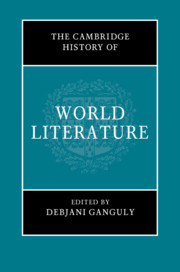Book contents
- The Cambridge History of World Literature
- The Cambridge History of World Literature
- Copyright page
- Contents
- Figures
- Contributors
- Acknowledgements
- Introduction
- Part I Genealogies
- Part II Thinking the World
- Part III Transregional Worlding
- Part IV Cartographic Shifts
- Part V World Literature and Translation
- 27 Translating Iconoclasm: Sino-Muslim Azharites and South-South Translations
- 28 The Avant-Garde Journal between Maghreb and Levant
- 29 The “Forgers” of World Literature: Translation, Nachdichtung, and Hebrew World Poetry
- 30 World Literature as Process and Relation: East Asia’s Russia and Translation
- Part VI Poetics, Genre, Intermediality
- Part VII Scales, Polysystems, Canons
- Part VIII Modes of Reading and Circulation
- Part IX The Worldly and the Planetary
- Index
- References
29 - The “Forgers” of World Literature: Translation, Nachdichtung, and Hebrew World Poetry
from Part V - World Literature and Translation
Published online by Cambridge University Press: 17 August 2021
- The Cambridge History of World Literature
- The Cambridge History of World Literature
- Copyright page
- Contents
- Figures
- Contributors
- Acknowledgements
- Introduction
- Part I Genealogies
- Part II Thinking the World
- Part III Transregional Worlding
- Part IV Cartographic Shifts
- Part V World Literature and Translation
- 27 Translating Iconoclasm: Sino-Muslim Azharites and South-South Translations
- 28 The Avant-Garde Journal between Maghreb and Levant
- 29 The “Forgers” of World Literature: Translation, Nachdichtung, and Hebrew World Poetry
- 30 World Literature as Process and Relation: East Asia’s Russia and Translation
- Part VI Poetics, Genre, Intermediality
- Part VII Scales, Polysystems, Canons
- Part VIII Modes of Reading and Circulation
- Part IX The Worldly and the Planetary
- Index
- References
Summary
In the years following World War II, modern Hebrew poets like Leah Goldberg wrestled with the rupture from European culture and their own longing for it against Zionism’s “rejection of the diaspora.” In this context, translation allowed for a continued dialogue with past and present Europe, while it also constituted a vital investment on behalf of a national literature in Hebrew. Anthologies of shirat ‘olam, world poetry, appeared with greater frequency in the post-war years, both to increase the corpus of world literature in Hebrew translation and to position Hebrew as a national literary language on the world stage. This chapter explores how an understanding of world literature took shape in early twentieth century Hebrew literature, and particularly in the field of poetry, where translated poems circulated widely in a range of formats, from radio broadcasts to newspapers and anthologies. Drawing from Goldberg’s oeuvre, this chapter considers her translation activity as part of a broader discourse on “world literature” in early to mid-twentieth century Hebrew literary culture, one that privileged, as I show, a European world literary model. Goldberg’s translations of the poetry from Far Eastern languages, specifically Chinese and Japanese poetry, both expand and complicate the coordinates of her world literary map. The inclusion of Chinese and Japanese poetry in translation expanded her poetic map “beyond Bialystock” and Tel Aviv, but as translations mediated by German translation and European Orientalism, they bring into relief a critical tension between “the far and the near” that underlies world literary models in general, and the case of the Hebrew ‘olam in particular.
- Type
- Chapter
- Information
- The Cambridge History of World Literature , pp. 544 - 565Publisher: Cambridge University PressPrint publication year: 2021

